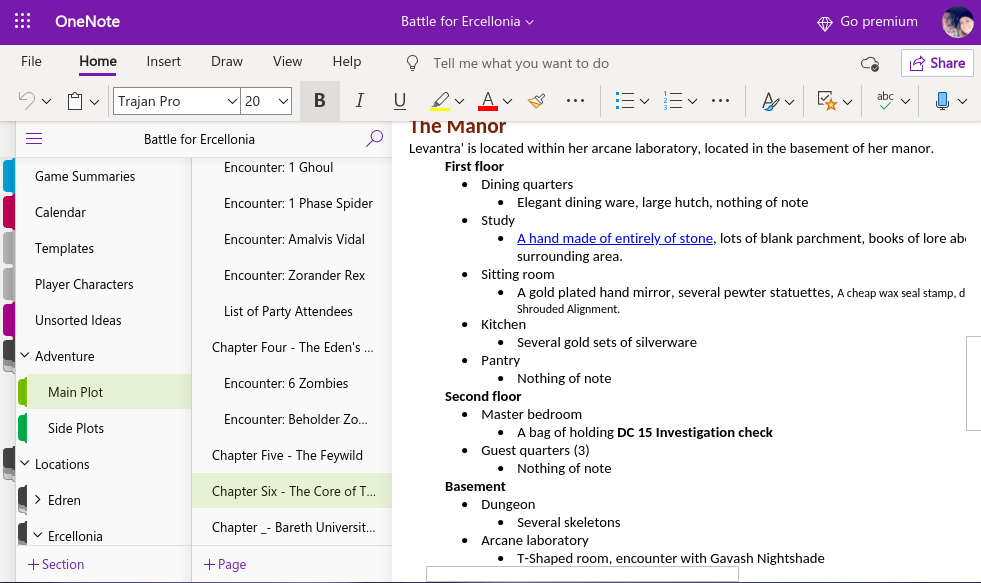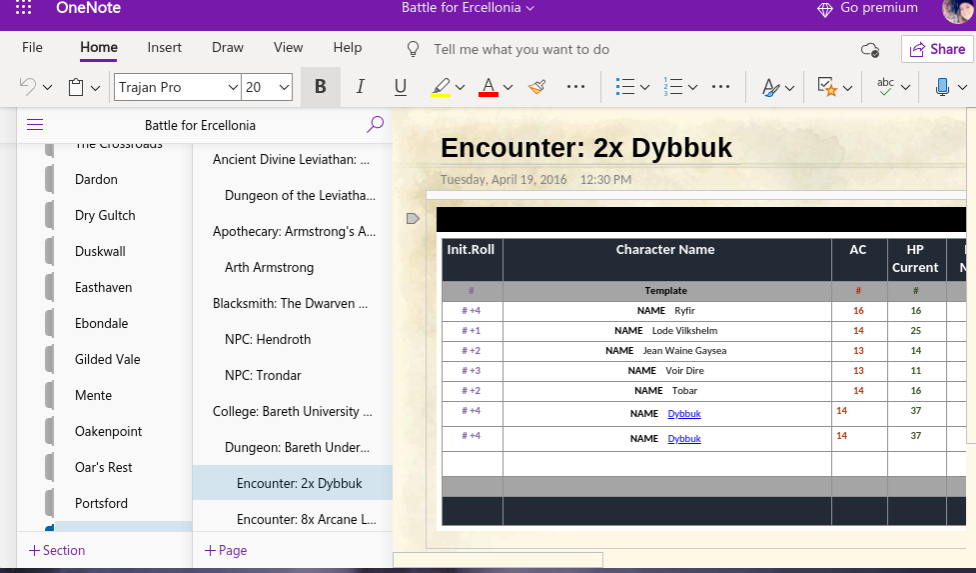Session Prep - Campaign Notes, Lore, NPCs, and More
This post is another in a series that I outline what I've tried as part of preparing for a session for the D&D 5e campaign I'm currently running. Check out the first post in the series to follow along from the beginning.
Initially, I tried writing everything down in Markdown, with the goal of putting it through a processor like Homebrewery to make it look official. The first few sessions are now saved in a PDF with formatting that makes it look semi-official. It's great for following along after the fact, but for running a session, keeping notes about various NPCs, plot hooks, locations, lore, and everything else, I wanted something a bit easier to maintain.
For a while, throughout the Battle of Ercellonia campaign I'm running, I used OneNote to manage all of my content and organize the lore into something I could quickly navigate. I ran the entire campaign from various OneNote pages, from the adventure outline:

To actually running a combat encounter:

OneNote was super useful. It allowed me to link to specific sections on other pages, making it really easy to write out a plot hook, and then go back through and link any of the names to pages about the NPCs or locations or events. I started using OneNote after coming across the wonderful template that /u/cryid posted on /r/DMToolkit a few years ago. With the templated pages, I build out lore, locations, NPCs, plots, and even detailed articles about flora and fauna that I had started to build out.
I built out templates for towns, encounters, items, lore and anything else I'd create regularly. Encounters, for example, would be a table (seen above) that had the names and stats of the player characters. From there, I could easily add a new creature to the mix, as well as a link to their statblock. When the encounter started, I'd have a column ready to track initiative, and could run the whole thing from one view. Towns would have a breakdown of imports/exports, demographics, links to the closest other towns, and notable NPCs that the players might encounter.
Each town had its own section, which had pages for each named location. These named location pages had a description of the history of the location, what it generally looks like, any distinguishing features, etc. The was also a reference photo to help come up with additional descriptive details. Stores had detailed inventories, each with links out to specific items that had detailed pages of their own.
NPCs would have their own statblock, a reference picture to help in describing them, and their backstory, by default. If the players had encountered this NPC, they'd also have notes on what that encounter was like, how they view the player characters, and what actions they'll take after their last encounter with the party. Not all of those actions would involve a future interaction with the party, but my goal was to make sure I had plans for everything to make the world I came up with seem more believable.
Maintenance of this all in one book eventually got to be too cumbersome to handle. I'd have sections of the book dedicated to every magic item I had created, alongside every bit of lore I created, and every location in this setting alongside all of that as well. Navigation became a bit tough, so I broke them apart. I ended up with two notebooks in OneNote - one specifically for the campaign, which included all of my locations, plots, NPCs, etc - and another for any rule, item, spell, monster, or non-campaign specific information that I would want to link to. My thought was that if I built up this resource book of all the non-campaign specific information I could possibly want, I could share it with the other DMs in our group, and have a shared lorebook for anyone else who wanted to DM to utilize.
In theory, it sounded great, but ultimately, it never came to fruition, so I found myself jumping through multiple hoops to keep the two sources separate for nothing. Being able to link between the different notebooks was helpful, but in practice, it required switching notebooks on the fly, which OneNote wasn't particularly fast at. Not being able to check a creature's description, or look at their statblock in greater detail during an encounter would really slow down the flow of a session.
With the additional lorebook, as I referred to it, I found myself encountering writers block as things grew larger and larger in scope. It was helpful to have everything at my fingertips, but also incredibly debilitating to have everything at my fingertips. Instead of just planning for the next session, I was also building out an entire setting from the ground up, in great detail. While I'm still building out a setting, being able to see literally everything all the time in OneNote would often get overwhelming and I'd get discouraged from writing.
Ultimately, my notebooks were incredibly useful, but the sprawl made it difficult to continue. Although it's definitely a problem of my own doing, I looked elsewhere for campaign and world management, and came across WorldAnvil. I plan to write more about WorldAnvil in the future - how I have things set up and that sort of thing. But for now, I'll just mention that the level of organization I have in WorldAnvil keeps me from getting overwhelmed at the amount of stuff I have written down. The prompts they provide help keep the motivation to continue writing, and since moving to WorldAnvil, I've written almost 42,000 words.
OneNote, despite not being the tool I ended up running with, was a huge help in organizing my setting ideas out of just a linear mess, and giving me the structure to build everything. I'd definitely recommend OneNote as a solution for managing campaign notes, especially for pre-made modules/campaigns that have a definite amount of content. Now, after all this writing about preparing for sessions, I think I should probably go prepare for my next one!